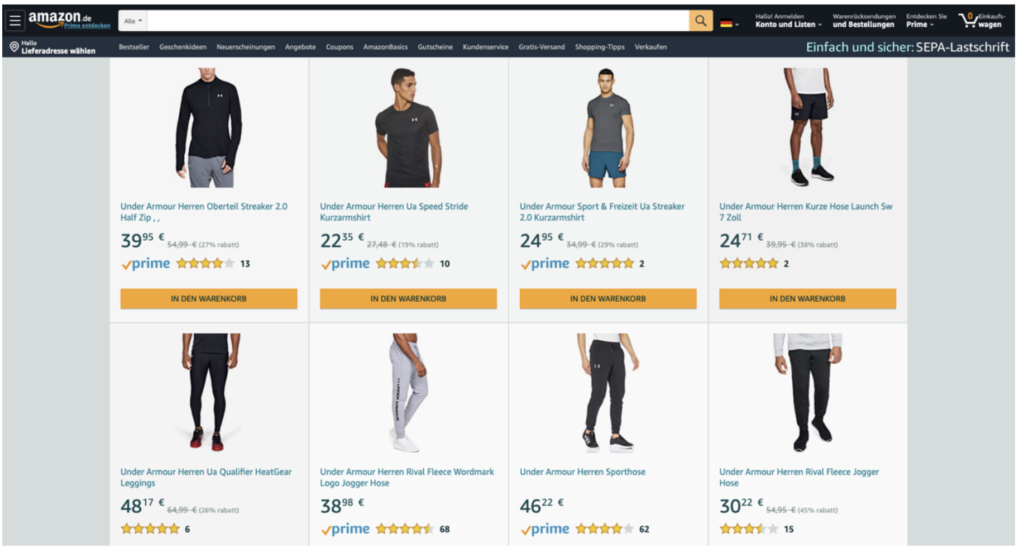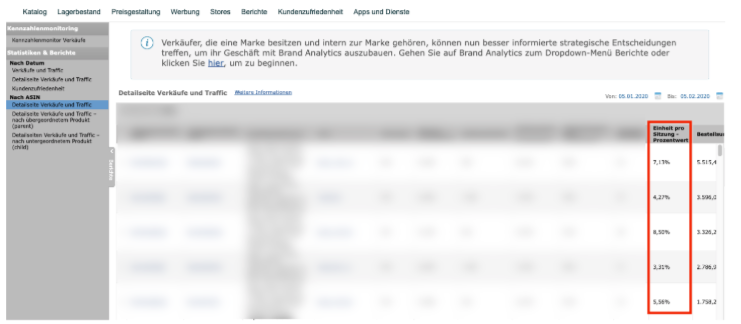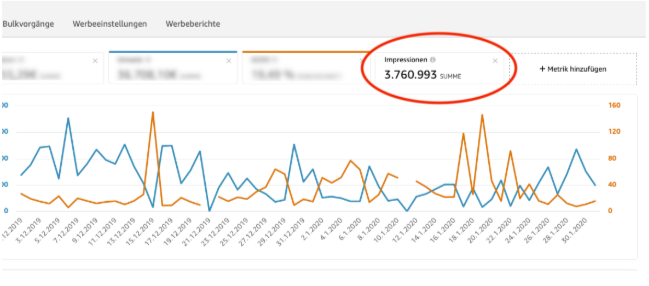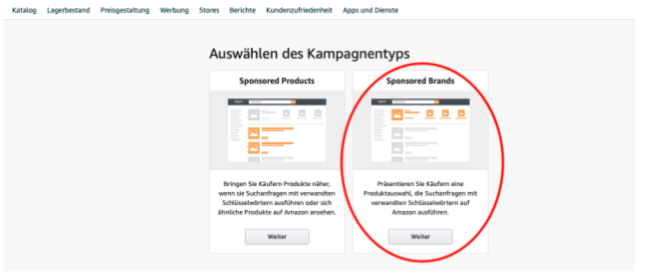As we explained in our previous article on Amazon PPC Tools, it is imperative for Amazon salespeople today to take advantage of the opportunities that Amazon PPC offers. Almost without exception, every successful seller places ads on Amazon. Often, however, the focus is on the Sponsored Products campaigns, which make up a large part of the advertising on Amazon. The Sponsored Brands ads are neglected by many sellers. However, this type of advertising also offers enormous potential to increase sales figures, raise your own brand awareness and generate more sales. That is why we take a closer look at Sponsored Brands advertising in this article. You will learn how to create your Sponsored Brand on Amazon, what you should consider when placing these ads, for which purposes they are useful and how you can increase your sales figures through Sponsored Brands.
Requirements for Sponsored Brands
In general, the advertising option Amazon Sponsored Brands is available to all sellers and vendors. So if you have a professional seller account and your brand is registered in Amazon’s trademark register, you can start using Sponsored Brands today.
What are Amazon Sponsored Brands?
Amazon basically offers sellers on their platform three options for advertising. While the offered products are directly advertised by sellers with Sponsored Products and Sponsored Display, Sponsored Brands (previously: „Amazon Headline Search Ads“) offers the possibility to promote your brand. As with the other PPC advertising options, Sponsored Brands also follows the Pay-Per-Click logic, which means that the advertiser seller only pays if the customer clicks on the ad. The customer is shown three different products of your product range. In addition, you have the possibility to create another field with your individual brand logo and text. The ad will then be displayed either before the competitors‘ search results or at the bottom of the page below the products.

With Sponsored Brands, almost no customer will miss the ad simply because of its size. It also offers the advantage that not only one product is advertised, but three and you can also design another field according to your own wishes with customizable text. This way you can better highlight your own brand awareness or advertise neglected products.
Where is the customer led when clicking?
By clicking on the individually created field, the customer is either directed to your Brand Store or to a search results page that contains only your products. If the customer clicks on one of the three advertised products, they will be taken directly to the product detail page for that item.
The Brand Store
The Amazon Brand Store is your own online shop on Amazon. You can easily design it using the drag & drop principle and present your entire product range. Each Brand Store is accessible via its own address (www.amazon.de/markenname). Here you can categorize your products and create your own landing pages. In the case of Sponsored Brands, you can choose whether the customer is directed to the start page of your Brand Store or to a special product category. The Brandstore looks like this:

Your search results page
In addition to linking to the Brand Store, you also have the option of directing the customer to a search results page where only your products are displayed. In addition to the three products that you advertise in your Sponsored Brands campaign and which must be included on the page, you can add as many other products to this page as you like. After clicking on the customizable field in your campaign, these products will also be displayed to the customer. The whole page looks like this:

Which one of the two pages you link is of course up to you and your marketing goals. You will find more information on this in the following chapter on KPIs. While the Brand Store is more likely to increase your own brand awareness, the Product Details page is best used to showcase products that you want to push or that need to be sold.
Best Practice
After all the theory we now come to the crucial part – the practice. In the following you will learn how to get the best out of your campaign and how to achieve your defined marketing goals.
Define your KPI’s
In order not to create false expectations or to get different results than planned, it is important to define your KPIs (= Key Performace Indicator) in the beginning. What expectations do you have for your campaign and what do you want to achieve with it? As different as some Amazon sellers are, as different are their marketing goals.
Increase sales figures
If you want to increase the total number of your sales on Amazon, you need to keep your eyes on certain key figures. It is especially important that you generate traffic to your listing in the first step and generate sales in the second step. This means that potential customers should also click on your ads when they see them and then buy as well. Therefore you should pay special attention to the CTR (= Click Trough Rate) and the CR (= Conversion Rate). The Click Trough Rate measures how many people who view your ads click on them, while the Conversion Rate measures how many people who clicked on your listing ultimately buy the product.
So a higher CTR and CR will have a positive effect on your sales. There are several ways to increase these figures. The CTR mainly depends on the cover picture and title, as this is the only part of your listing that the customer sees before clicking on the product. Therefore it is important to optimize these two factors on an ongoing basis. It can also help to add relevant keywords to your campaign that you have not yet considered and to switch off irrelevant keywords. These measures should boost your CTR significantly. You can then optimize the CR by making adjustments to the listing itself. You should pay particular attention to high-quality product images, clean and comprehensible bullet points, and a good product description. Especially the pictures can be a real gamechanger on Amazon, as this is the part of the listing that, in our experience, the customer pays most attention to.
As already mentioned, it makes sense to link your search results page to other products when clicking on the customizable field in the Sponsored Brands campaign instead of the Brand Store. This way the customer is more likely to buy a product from you than from a competitor. Especially since you can select the products displayed on this page, it helps you to increase your sales figures for the desired products.
You can find your conversion rate per product under >Reports >Statistics & Reports > To ASIN. You can find your CTR per keyword under your advertising reports in the respective campaign.

As already mentioned, it makes sense to link your search results page with other products when clicking on the customizable field in the Sponsored Brands campaign instead of the Brand Store. This way the customer is more likely to buy a product from you than from a competitor. Especially since you can select the products displayed on this page, it helps you to increase your sales figures for the desired products.
Increase brand awareness
Another possible KPI, especially of slightly larger brands, can be to increase your own brand awareness. If this is your goal with your Sponsored Brands campaign, the impressions are an interesting KPI for you. This number indicates how many customers on Amazon have seen your ad. Therefore you can measure the reach of your campaign. Here you can vary with different products in the Sponsored Brands ad to see what works best and what is most likely to be outplayed by the algorithm. When you click on your brand logo in the ad, you should then link to your Brand Store so that customers can get to know your brand better and browse through your product categories.

You can find the impressions of your ad in Sellercentral under >Advertising >Manage Campaigns.
Boost neglected products
Of course, with Sponsored Brands you can also push neglected products that have not yet met your expectations or even sell out. Especially if you have several products of the same category on offer, Sponsored Brands ads can be useful. This way you can display three products of this category next to each other and increase the likelihood of the customer buying one of them. Again, you should especially increase the impressions and then try to optimize the CTR and CR as much as possible to make your campaign as profitable as possible.
Here it makes sense to link your search results page with additional products when clicking on the customizable field in the Sponsored Brands campaign instead of the Brand Store. This way the customer is more likely to buy a product from you than from a competitor. Especially since you can select the displayed products on this page, it helps you to increase your sales figures for the desired products.
Which keywords should I choose?
In contrast to sponsored products ads, you cannot automatically set up campaigns for sponsored brands. You will therefore have to choose your keywords for which your ad will be played. Therefore, the keywords must be highly relevant to the three products advertised. You can either use suggestions from Amazon or add keywords that you think are relevant. Since you have probably already done a keyword research for your listing, you can also use the most relevant keywords for your Sponsored Brands ad.
Generally, unbranded shorttail keywords are best suited for sponsored brand campaigns. With longtails it is often the case that the customer already knows which product he wants to buy. If he is looking for „men’s skin care product“, for example, it is likely that he has not yet decided on a specific product and wants to find out which products are potentially suitable for him. Here you should display your best selling skin care products and by clicking on the field with your logo you can provide him with a selection of further products on your product detail page.
In addition, it is always a good idea to take the well-running keywords from the automatic and exact Sponsored Products campaigns and use them for the relevant Sponsored Brands campaigns as well. Furthermore, you should define the keywords that you already know from your other campaigns that they perform poorly as negative exact. This is because often it is possible that, based on your set widths or phrase, you will be played out keywords that you already knew would perform poorly.
Which commandment should I choose?
For advertising campaigns on Amazon the CPC (= Cost Per Click) is particularly important. It indicates what you actually pay per click at the end. This varies depending on where your ad is played. If your ad is displayed before the organic search, you can expect to pay a higher CPC than if your ad is displayed at the end of the organic search.
As with Sponsored Products campaigns, you should always base your bids on the ACOS (= Advertising Cost of Sale) per product. In order for your campaign to break even, the ACOS of your product should only be as high as the margin of the product. Therefore you should constantly monitor the ACOS of your campaigns and adjust your bids if necessary.
Basically, I recommend you always start with a high fixed bid and then optimise your bids downwards. With fixed bids you know exactly what the PPC algorithm does and you have no variables in your bidding process that you cannot understand or interpret later. You then adjust the bids bit by bit until you have reached your target ACOS. Of course, you can also get closer to your desired ACOS by deleting irrelevant keywords. Through this process your campaign will become more and more efficient. Therefore, you can also play with this to see how your sales figures increase the fastest and most efficiently without becoming unprofitable in the campaign.
Grit tests for more success
As already explained, your Sponsored Brands ad is composed of several elements. However, you never know in advance which combination of the different elements will work best for your campaign. That’s why it makes sense to test different combination possibilities. You can change the three advertised products, change the order in which the advertised products are displayed, choose a different title text, choose a different image in the free text field, change the title images of the advertised products, etc.
Again, I do not recommend using a tool for a splitting test. You should rather make changes to the campaign on a regular basis. It is important to make only one change at a time, so that you know which change has led to which result. For example, if you change your photo, the text and the products of the campaign at the same time, you won’t be able to remember what led to the improvement or deterioration of your key figures. Therefore, you should make a small change once a week and see how it has affected you and use this information to decide whether to keep the change or not.
Frequently asked questions
How can I create a Sponsored Brand on Amazon?
If you meet the criteria for Sponsored Brands mentioned above, it is quite easy to place Sponsored Brands ads. To do so, go to >Advertising >Manage Campaigns >Create Campaign and select „Sponsored Brands“ as the campaign type.

Amazon will then guide you through creating the ad. You have to define the different components like the three advertised products, logo, individual text, links, keywords and bids.
Is it possible that my campaign is only displayed above the organic search?
Yes, this is basically possible. However, you will have to make a few changes to your campaign.

To do this, you have to deactivate the automated bids in the keyword alignment of your campaign. For the user-defined bid adjustment you then select „Lower by 99%“. This will result in you being displayed almost exclusively above the organic search.
What is the Win Rate?
The Win Rate describes the success rate of the played ads. So if you bid on ten ads and get played on seven of them, your Win Rate is 70%. In the past, Amazon has given an estimated success rate per keyword depending on the amount of bidding. This helped especially in finding bids, but is now a thing of the past.
Which categories are not eligible for Sponsored Brands?
Not eligible for advertising are currently adult products, used products, refurbished products and closed categories.
Conclusion on Sponsored Brand campaigns
In principle, anyone can create their own sponsored brand on Amazon. However, the most important factor is that you define your goals in advance what you want to achieve with your ads. Because Sponsored Brands Ads can be used in Amazon Marketing for very different purposes. If you know your KPIs, then these are the signposts that show you how to align your campaign to achieve your goals.

